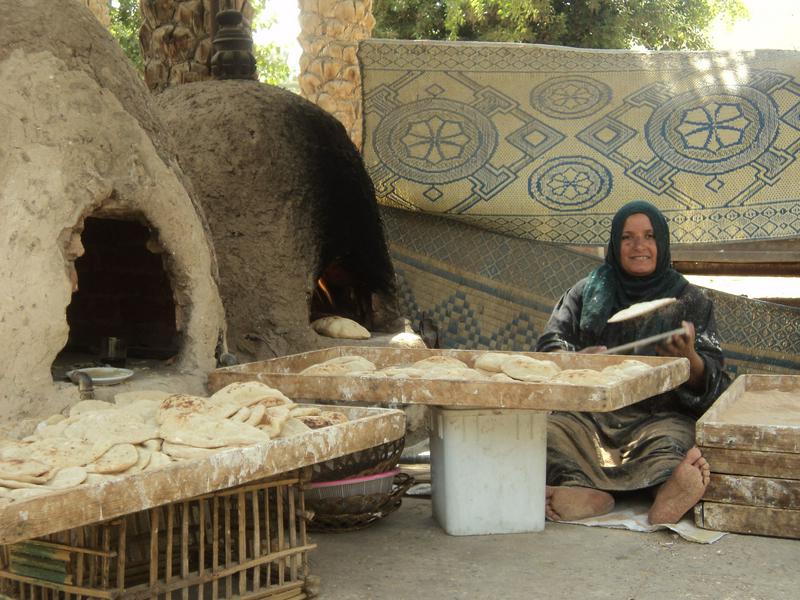Sliced Bread: The Best Thing Since…?
By | December 16, 2018
Woman Making Typical Egyptian Bread (Photo from Pinterest)
The history of bread is directly related to the history of wheat, which dates back as far as the ancient civilizations of Mesopotamia and Egypt. Growing wheat played a significant role in the development of civilization as it allowed mankind to settle in one place instead of following herds of animals to hunt and gather food. Once they were no longer forced into a migratory lifestyle, they were able to build permanent homes which would later lead to the building of cities.
At first, the wheat was consumed simply by chewing it, but eventually, it was ground into a fine powder and mixed with water to create a paste. The paste was then left over a fire for several days until it hardened into a flatbread. Raised bread was most likely created by accident when the paste attracted yeast spores before baking in the hot sun. Once it was discovered, people began to intentionally leave the paste out and wait for the yeast to make the bread rise, though they eventually learned they could speed up the process by saving a piece of dough from one batch and added it to the next. The grinding was originally done by pounding the wheat with rocks and then later it was done with mortar and pestle. In 800 B.C., the first mill would be created, which would use flat spinning stones to grind wheat. In 1865 A.D., a steel mill would allow the wheat to be ground into an ultra-refined flour used in cakes and pastries.
Recreating the Ancient Bakery (Photo from aeraweb.org/lost-city-project)
The first clay ovens, a vital tool in the baking of bread, were created in Asia 5,000 B.C. and used wood fires as a heat source. Around 1,000 B.C., the Egyptians learned to isolate the yeast and add it directly to the dough. At the same time, they began using bread to make beer by soaking it in water and sweetening it. They later discovered that the foam from the beer could be added to the dough for new bread to make it rise. Commercially-prepared yeast would not become available until the eighteenth century. Eventually, the practice of making bread spread from Egypt to Greece and all over Europe. The Romans favored bread and wheat over meat and even developed a welfare state which distributed grain to the people of Rome. For much of history, the color of a person’s bread was an indication of their social status. Whiter flours were more expensive and difficult to produce so the darker bread was associated with lower status. This is in direct contrast with the pricing trends of today in which darker bread is considered healthier and therefore more expensive.
French Revolution (image from reference.com)
During the dark ages, bread was one of few foods to keep the poor alive. During the French Revolution, the lower class rioted due to the lack of bread. This is what led to the untrue claim that Marie Antionette had said, “Let them eat cake,” in response to the bread riots. This claim was presented as evidence of how oblivious the royal class had become to the suffering of the lower class.
While wheat was instrumental in the development of civilizations, bread has become symbolic in religion. It has been used in rituals such as communion during which the bread represents the body of Christ. The Lord’s Prayer refers to “daily bread” which symbolizes both nutritional and moral sustenance. Bread has also achieved economic importance, being a slang term for money and being used in the reference of “bread and butter” as a person’s primary source of income.
Rohwedder’s slicing machine (photo from americanhistory.si.edu)
While baking bread might have been “so easy a caveman could do it,” the creation of sliced bread for commercial distribution was a bit more challenging. It was first introduced on July 7, 1928, by a bakery in Chillicothe, MO. The bread had been cut using an automatic bread-slicing machine created by Otto Frederick Rohwedder. The public was unimpressed, due in part to the sloppy appearance of the loaves. However, another unforeseen side effect was how quickly the bread became stale after being sliced. An attempt was made by Rohwedder to resolve this issue by using pins to keep the loaf intact after it was sliced. Ads for the newly sliced bread provided instructions for the consumers to pull out the pin before removing the slices of bread.
Panera Bread in Chicago (Photo from Wikimedia Commons)
Eventually, the idea of sliced bread caught on and become a staple in households across the country. So much so that when it was temporarily unavailable during World War II, as an attempt to conserve the steel required to make the automatic slicing machines, the public was outraged, resulting in the ban being lifted after only two months. These days, grocery store shelves are filled with fresh sliced bread daily and every new thing that comes along claims to be “the best things since sliced bread.”






